The most productive and delicious varieties of cherries
When choosing varieties for the next planting, gardeners pay attention to the care requirements, plant resistance to diseases, marketability and taste of fruits. It is important to determine in advance for what purpose the crop is grown. For sale it is recommended to plant late yielding varieties, for fresh consumption - early maturing and unpretentious in care. Let's consider the best varieties of cherries, their features, yield indicators and growing rules.
The content of the article
Types and varieties of cherries
Varieties are classified according to the ripening period - early, mid-season and late. They also distinguish undersized and weeping varieties - depending on the shape and size of the crown. Choosing the right variety affects the yield, taste and size of the fruit. When buying a seedling, it is recommended to study the characteristics and characteristics of the variety, prepare the garden soil and planting site in advance.
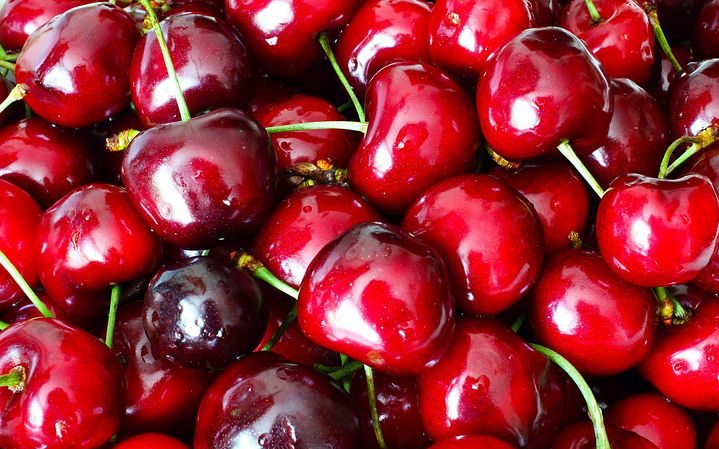
Frost resistant
Frost-resistant varieties of cherries can withstand temperatures as low as -30 ° C. Such varieties are grown in regions with an unstable climate and cold weather - in the Urals, Siberia and the Far Eastern region.
Bystrinka
Cherry Bystrinka withstands frosts down to -45 ° С. Partially self-fertile, unpretentious in cultivation. The height of the tree is up to 2.5 m, the crown is semi-spreading. Rounded berries, weight - 3.6 g, balanced sweet-sour taste. Harvest is used for making jam, compotes, tinctures, jams.
Radonezh
The early-fruiting medium-late variety Radonezh begins to bear fruit in the fourth year after planting. The berries are distinguished by attractive commercial qualities - round, with a burgundy glossy peel. Weight - about 4 g, firm flesh, sweet and sour taste. Tasting score - 4.2 points. Cherry Radonezh is resistant to insect pests, rarely suffers from coccomycosis and powdery mildew. There is drought immunity.
Sverdlovsk
Frost-resistant variety is unpretentious in cultivation, suitable for the Urals and Siberia. Fruit weight - about 3 g, rounded shape. The rind is burgundy, glossy. The yield from a tree is about 10 kg per summer. The taste is sweet and sour, pleasant. Sverdlovchanka cherry is universal in application.
Self-fertile
Self-fertile cherry does not need cross-pollination and pollinating insects. The tree bears fruit every year, is distinguished by its yield. Self-fertile varieties are especially popular among amateur gardeners.
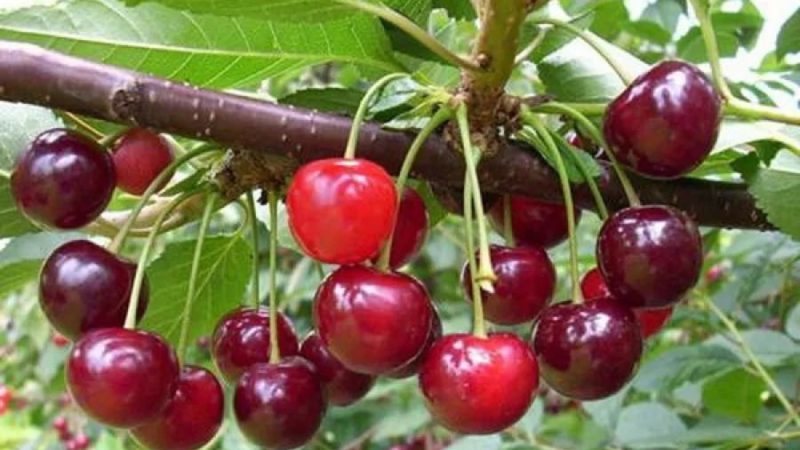
Apukhtinskaya
Cherry Apukhtinskaya bears fruit in the second year after planting. The height of the tree is from 3 to 7 m, the crown is oval. Fruits are dark red, round-heart-shaped, weight - up to 4 g. The oval stone is easily separated from the sweet-tart pulp. Apukhtinskaya ripens at the end of summer, the yield is about 12 kg per tree. The variety is unpretentious in care, but it is recommended to pay attention to protection from diseases - to regularly spray the plants with the preparation "HOM".
Lebedyanskaya
The tree is fast-growing, medium-sized. Fruits are cordate-round, weight - about 5 g. Color is dark red, attractive, with glossy sheen. The pulp is tender and juicy, medium density. Cherry Lebedyanskaya is good in fresh, frozen, dried form. The plant is planted in southern regions with fertile lands - cherry needs food, sun and warmth. Average frost resistance.
Khutoryanka
Mid-season self-fertile variety.Fruit weight - about 3.4 g, rounded oval shape, maroon color. The pulp is homogeneous, the juice is dark. The taste is sweet, with a pleasant astringency. The farmer starts bearing fruit 3-4 years after planting. Productivity - from 10 to 17 kg per tree - depends on the region of cultivation. The fruits are transportable, differ in their commercial qualities.
Stunted (dwarf)
Dwarf cherry trees adorn any area - they look original and take up little space. Summer residents plant low-growing cherries as a hedge, instead of concrete and brick fences.
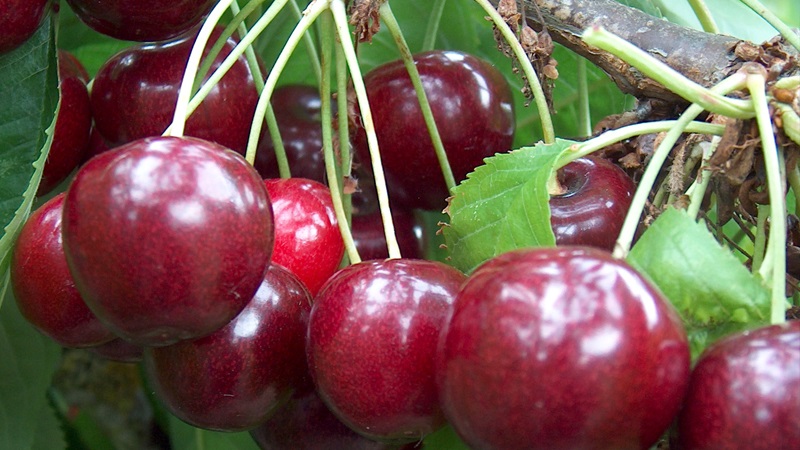
Ashinskaya
The height of the tree is 2.5 m, the leaves are of medium length, the crown is conical. Fruits are round-oval, weight of one - up to 4 g. Skin is glossy, color is maroon. The pulp is red, juicy, the taste is sweet and sour. The small bone is easily separated from the pulp. Ashinskaya cherry blossoms after May 20, the harvest is harvested in late July or early August. Cherry is resistant to coccomycosis and drought, unpretentious care.
Abundant
Compact bush, height - 2.5 m, oval crown. Late variety - blooms in late May, bears fruit in the second decade of August. The weight of dark red berries is 2 g, the shape is round-oval. The pulp is tender and juicy, the taste is sweet and sour. Cherries do not crack, they use the crop for processing and sale. Cherry Abundant is appreciated for its commercial qualities and prolonged fruiting period - they are harvested in 2-3 stages.
Interesting! Gardeners of the middle lane planted Anthracite cherries on the site. The plant is unpretentious in care, the fruits are sweet, versatile in use. Taste is rated at 4.9 points out of 5.
Zagoryevskaya
Compact trees are unpretentious to maintain. The crown is spreading, wide. The berry weight is about 4 g, outwardly Zagorievskaya looks like a sweet cherry. The taste is sweet and sour, dessert. The juice is thick, burgundy. The bone is easily separated from the pulp. The yield is about 14 kg per plant. In the process of harvesting, the fruits do not crumble, the variety is drought-resistant. The variety is planted in Moscow and the Moscow region.
Octave
The crown is round, compact, tree height - 2-3 m. Fruits are dark cherry, average weight - 3.9 g. The color is claret-black, shiny. The peel is dense, so the crop is kept and transportable. The stone is round, small, easily separated. The flower buds are frost-resistant, so the Oktava cherry is grown in the middle lane.
Weeping
Weeping cherries are planted in spacious areas - a drooping, spreading crown requires a lot of free space. In care, such trees are unpretentious - no need to waste time on pruning and shaping.
Shubinka
The tree is vigorous, the crown is of medium density. Fruits are round-flat, weight - 2.5 g. The stem is long, the skin is burgundy, thin. The pulp is medium-dense, burgundy, friable. The taste is sour, the stone is small. The advantages of Shubinka cherries include frost resistance, the disadvantages are sour taste, average immunity to diseases.
Hope
The height of the tree is up to 6 m, the crown is wide-pyramidal, drooping. Fast-growing shoots, long internodes. Fruits are round-oval, weight - up to 6 g. The pulp and juice are dark red. The taste is sweet with pleasant sourness and rich cherry aroma. There is no astringency or bitterness. Cherry Nadezhda ripens in late June or early July, bears fruit for 4-5 years after planting. Productivity - from 9 to 15 kg of berries per year. From the description of the cherry variety Nadezhda it follows that winter hardiness and drought resistance are average.
The most productive
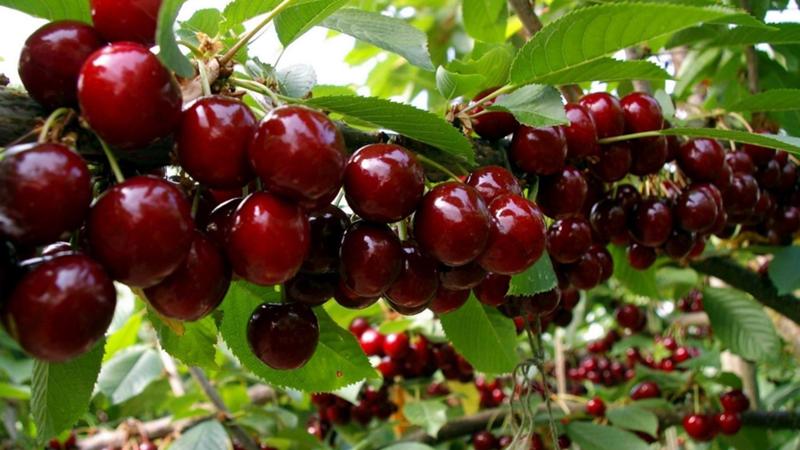
Yielding varieties of cherries are planted by summer residents and farmers. Some of the berries are used fresh, some are sent for processing - compotes and jam are prepared, added to baked goods or preserved whole with other berries and fruits. If the berries have a dense peel, then they are grown for sale - stored in boxes and transported over long distances.
Memory of Vavilov
The tree is fast-growing, the shoots are curved, the leaves are dark green. Fruits are one-dimensional, weight 3-4 g, heart-shaped. The rind is maroon, the stone is creamy. The variety is self-fertile, it is recommended to plant other cherry varieties nearby.The ripening period is the end of July, the yield is 16-22 kg per bush per season. The tree bears fruit in the fourth year after planting.
Parental
Subject to the agrotechnical rules, the Parent gives from 20 to 25 kg of harvest annually. Fruits are flat-round, weight - 3 g, burgundy color. Dessert pulp, sweet and sour, thick juice, dark red. Parental bear fruit for 2-3 years. Parent's cherries are planted mainly in central Russia. In the north, the buds will freeze, which will negatively affect the yield decline.
Kseniya
Partially self-fertile. The fruits are large, weight - from 7 to 10 g, round shape. The berries are burgundy, glossy. Fruiting occurs in mid-June - the harvest is harvested in two stages. Ksenia's cherry taste is sweet and sour, harmonious, rich cherry aroma. Productivity - up to 25 kg per tree. The advantages include frost resistance - Ksenia can withstand temperatures down to -25 ° C.
Ural sweet cherry
Compact trees take up little dream on the site, bear fruit on loamy and sandy loam soils. The Ural sweet cherry enters fruiting in the third year after planting. Berry weight - 5 g, wide-round shape, soft consistency. The taste is sweet with sourness, harmonious. The separation from the footboard is easy, the bone is small. The variety is partially self-fertile, medium resistance to drought.
Interesting! For long-term storage, cherries are harvested 10 days before they are fully ripe. The berries are not washed, put in wooden boxes and put away in a dry, dark place.
Early
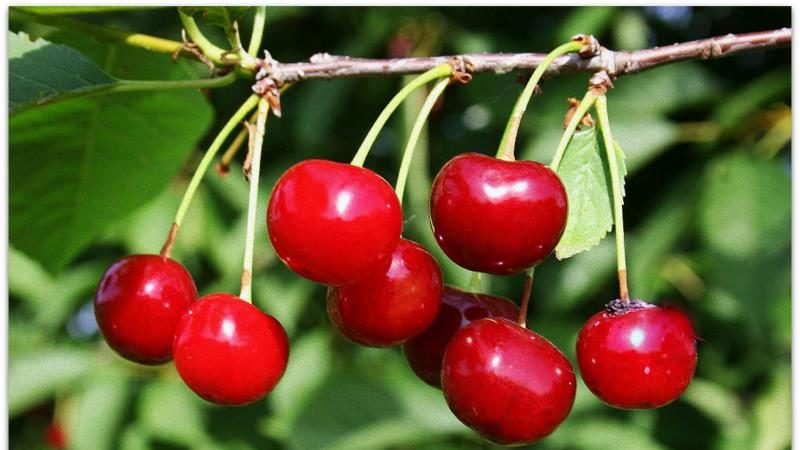
Early ripe cherries are grown in regions with short and cool summers. The harvest is harvested in July, the fruits are not inferior in taste and marketability to mid-season and late varieties.
Sap
The self-infertile variety Zhivitsa begins bearing fruit 4-5 years after planting. The first crop is harvested at the end of June. The berries are dark red, weight - 3.8 g. Zhivitsa is a duke - cherry and sweet cherry hybrid, therefore, the fruit is sweet and juicy. The bone is easily separated.
Garland
Cherry Garland ripens at the end of June. Fruit weight - up to 6 g, heart-shaped-round shape. The pulp is bright red, the taste is sweet and sour. Low-growing tree, 3 m high, straight shoots. Resistance to coccomycosis is average, immunity to diseases is strong. Cherries are used to prepare desserts and pastries, drinks and jams. The yield of the variety is about 25 kg per plant.
Bottle
The height of the tree is from 2.5 to 3 m, the crown is spherical. The berries are round or flat-round, weight - up to 3 g. Color red-pink, original. The rind is dense, slightly bitter. The pulp is very juicy, pink, streaked. The stone is small, easily separated from the pulp. The taste is classic cherry, pleasant and refreshing. The variety is self-infertile, average frost resistance, the harvest is harvested in late June or early July.
Late
Late ripening cherries ripen in August. The berries are large and juicy, the pulp is sweet and sour, harmonious. Late varieties need special leaving- summer residents regularly fertilize the soil superphosphate and manure, trees are sprayed with a solution of Bordeaux liquid to protect them from pests.
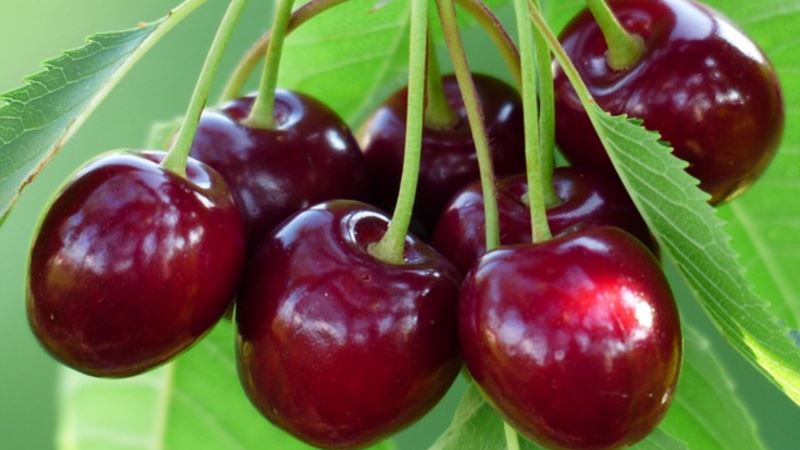
Putinka
The height of the tree is up to 3 m, the crown is dense, drooping. Fruit weight - 5-7 g, wide-round shape, glossy, burgundy rind. The pulp is juicy, dark red, the taste is sweet and sour. Tasting score - 4.6 points out of 5. Putinka is planted in mid-April, the seedlings are sensitive, need nutrient soil. Average frost resistance, the variety is resistant to coccomycosis.
Vianok
A fast-growing variety of medium late ripening. Winter-hardy, unpretentious care. Fruits are round, weight - 3-4 g, burgundy-red color. The pulp is of medium density, juicy. The taste is sweet and sour, balanced. The crop is used fresh, frozen and dried. The fruits do not crumble during harvest and do not crack.
Winter pomegranate
Self-fertile late-ripening variety is ideal for growing in Siberia. Resistant to disease, blooms in May, harvested in August. Dwarf tree, height - up to 2 m.Fruit weight - about 4 g, burgundy-red color. Productivity - up to 10 kg per tree per season. In application, the Winter garnet is universal.
The best cherry varieties for the Nizhny Novgorod region
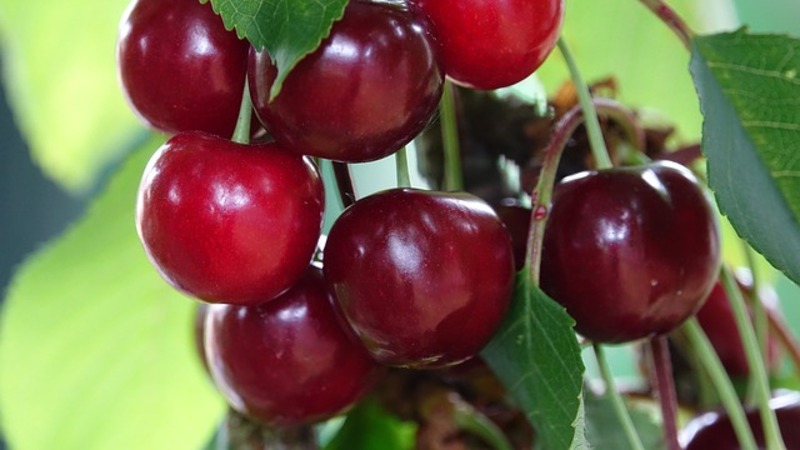
For planting in the Nizhny Novgorod region, gardeners choose frost-resistant varieties for planting so that the cherry does not suffer from precipitation, winds and sudden temperature changes... One of these varieties is Zvezdochka cherry. It can withstand temperatures as low as -38 ° C and is unpretentious in cultivation. The root system is developed and powerful - the tree independently provides itself with moisture. The sprocket is resistant to diseases and insects. Fruits are round, scarlet in color, weight - 4-5 g. The pulp is tender and aromatic, the taste is sweet with sourness. Zvezdochka blooms in May, the crop is harvested in June-July.
Another variety for planting in the Nizhny Novgorod region is the memory of Yenikeev. Ripening period - end of June, yield - from 8 to 15 kg per plant. Plant height - 3 m, fruits are large, heart-shaped. The pulp is sweet, juicy. Taste qualities are estimated at 4.8 points out of 5. The purpose is universal, delicious jams and preserves are obtained from cherries, fruits are frozen for the winter and compotes are boiled.
Attention! Gardeners recommend paying attention to the Rasplet variety. Cherries endure drought and frost, rarely get sick. The height of the tree is about 2.5 m, the life span of the tree is about 15 years. Berries are maroon, weight about - 4 g. highly self-fertiledoes not require pollinating neighbors or insects. The berries ripen by the end of July.
Conclusion
The most productive varieties of cherries are Parent'skaya, Vavilov's memory, Ural cherries; the most frost-resistant are Bystrinka, Radonezh, Sverdlovchanka. Dwarf varieties stand out among all - Ashinskaya, Izobilnaya, Oktava. The height of the bushes is no more than 3 m, they look original and decorate the site. It is recommended to read reviews of other gardeners before planting, study the information on the package. When choosing, it is important to know the ripening period of cherries. The early fruits are harvested at the end of June, the late ones in August.